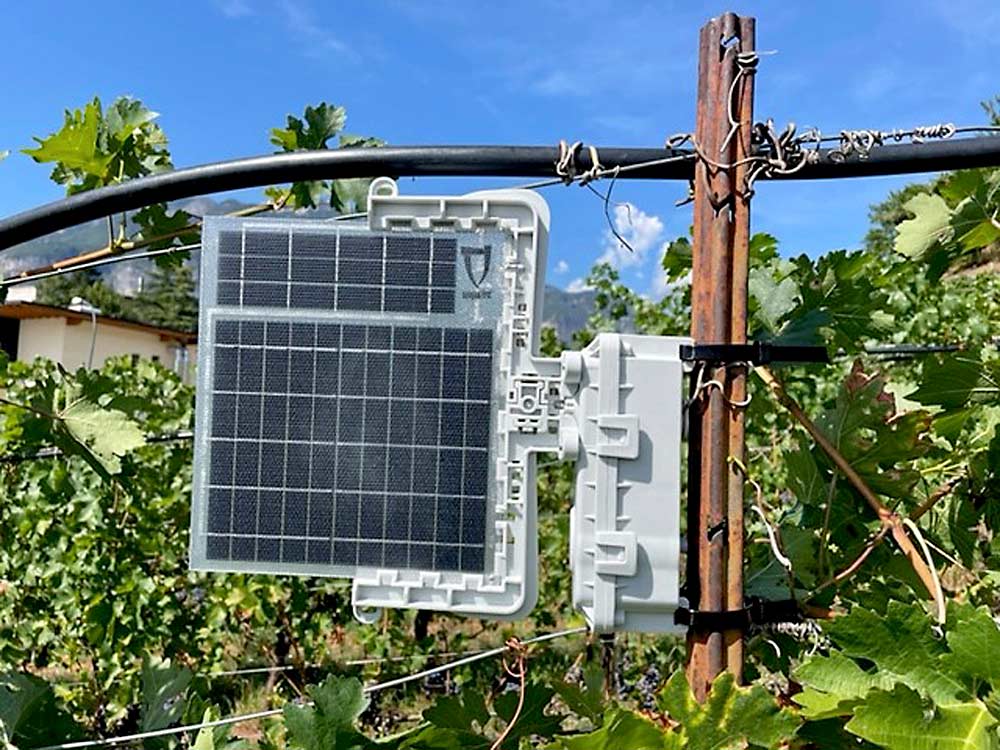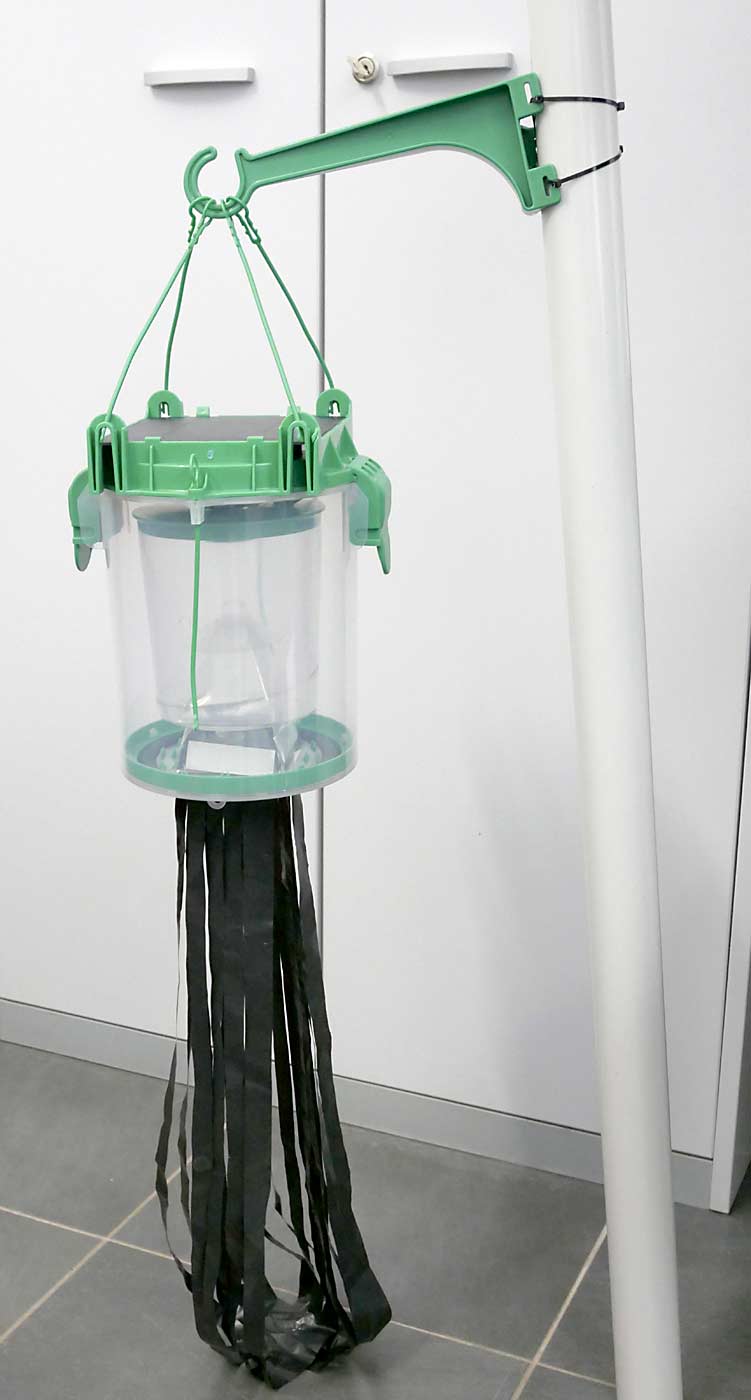
Insects use pheromones to find mates. Scientists have long known this and have developed mating disruption programs widely used by growers today.
But insects also find mates with vibrations: pickup lines, responses and rivalry challenges all broadcast through plant tissue. Researchers in Italy, California and Washington are trying to use those shaky mating calls against the orchard and vineyard pests that make them. If it works, vibrational signaling could join pheromone disruption, early detection, trapping and other tools as part of successful integrated pest management strategies.

“It’s complementary to what we have right now with IPM,” said Rachele Nieri, a biologist at the University of Trento.
Nieri has been involved with two veins of vibrational signaling research. One entails playing recorded American grapevine leafhopper vibrations along a vineyard trellis wire to disrupt the pest’s mating cycle. The other uses the mating call of a brown marmorated stink bug to augment a pheromone trap.
The leafhopper project is nearing commercialization.
In 2017 and 2018, in a commercial vineyard in Northern Italy, playing mating calls through trellis wire led to a 50 percent decrease in leafhopper population compared to the control with no vibrations.
Buoyed by the results, the university partnered with Agro Electronics of Milan, a research and development unit of CBC Europe, to build prototypes. They came up with Tremos5, a solar-power shaker that hitches onto a vineyard post.

The device emits the recorded call of a male rival leafhopper, which throws the mating duets of nearby males and females off tune and thwarts their reproductive game. Triggered by a temperature threshold, the machine creates a near continuous loop of quivering, with only short pauses, Nieri said, because duetting leafhoppers don’t waste much time.
By the way, entomologists in this field really use the word “duets” to describe such tremulatory courting rituals. The field of study is called biotremology.
Agro Electronics held a few trials last year but plans areawide tests this year in 110 acres in different growing regions of Italy and one small trial in Champagne, France, over a variety of growing conditions, climates and cultivars.

The target price for enough shakers to cover one acre is $3,750 to $5,000, said Marco Baldo of Agro Electronics. The Tremos5 broadcasts about 165 linear feet.
For brown marmorated stink bug, the company has already sold nearly 2,000 Shindo Traps that use both vibrations and pheromones. The bimodal traps emit pheromones to attract the stink bugs over long distances and a female mating vibration song to convince them to wander inside.
The traps caught more adult and nymph stink bugs than the pheromone-only traps. Unexpectedly, they also caught more females than males. Nieri was unsure why, though insects often exhibit rivalry mating behavior, including vibrations.
A U.S. Department of Agriculture research entomologist in California’s San Joaquin Valley is running similar studies trying to put the rival shaking to use against glassy-winged sharpshooter, a leafhopper cousin responsible for transmitting Pierce’s disease.

Also using a Tremos shaker, Rodrigo Krugner plays the recorded song of a “dominant” female sharpshooter — one who has already found a male suitor — through the wire to ward off other females looking for a mate. In a 2018 caged field trial, only one mating pair of 134 released onto the vine mated amid the playback, compared to 28 pairs of 134 released on the silent control vine.
Krugner is conducting similar research on other vineyard pests, including the Virginia creeper leafhopper and the spotted lanternfly. They are among the 200,000 insects known to use vibrations as at least part of their mating communication. (Leafhoppers and sharpshooters rely solely on vibrations, he said.)
He also is studying how sharpshooter mating signals vibrate through the ground, which is good news because some pests overwinter in freestanding vegetation outside vineyards, such as citrus trees, where there are no wires. Meanwhile, a Florida colleague is studying vibrational manipulation in Asian citrus psyllid.
Vibration technology has promise for Washington’s wine grape industry, said Doug Walsh, a Washington State University entomologist.
However, he has concerns.
For one, the price tag may be economically unrealistic, he said.
Also, the Virginia creeper leafhopper overwinters outside the vineyard, entering each spring to lay eggs. The shaker tool would only disrupt the second-generation mating, he said.
Meanwhile, other research shows that any vibrations through a trellis wire, whether tailored to a specific insect or not, create enough hum to disrupt mating.
“I wouldn’t think it really needs to be species-specific,” Walsh said.
Nieri thinks it does.
Her team tested white noise, as a check, and it worked, she said. It masked everything.
However, it takes a lot more energy to transmit a broad range of white noise frequencies long distances; it could disrupt behavior of nontarget arthropods, including beneficials; and the pest may habituate to continuous exposure.
“For sure a white noise works, for a short time, but I do not think it is a convenient strategy,” she said.
—by Ross Courtney
Pear psylla vibrational mating disruption research shows promising results
A Washington State University doctoral candidate is testing a vibration disruption approach with pear psylla.
Psylla and other insects find mates by pheromones and vibrations transmitted through plant tissue.

Entomology student Dowen Jocson set up trials in greenhouses and two outdoor research orchards to compare how many offspring were produced on plants with a recording of a male mating vibration, a control treatment of no artificial vibrations at all, and “white noise,” the vibrational equivalent of a consistent hum or static.
White noise was most effective both in greenhouses and outdoors. The psylla call playback was an improvement over the control, but not as effective as the white noise.
Though Jocson spent hours in a sound-room recording psylla calls, this did not surprise her. Based on her work with other insects, Jocson hypothesized that white noise might do the trick by either drowning out the mating songs or causing so much racket the bugs wouldn’t even try.
She likens the dynamic to a club with music too loud.
“You can’t even get their name or their number, so what’s the point?” she said.
Jocson gathered two years of data in Pullman, Washington, greenhouses and one year at WSU’s Sunrise research orchard near Rock Island and the Wenatchee Tree Fruit Research and Extension Center. The greenhouse treatments produced statistically different results for all varieties tested. The outdoor trial results showed statistically different results for Anjou, which are more sensitive to psylla than are Bartlett.
She and Robert Orpet, a WSU-Wenatchee research entomologist, are seeking grants to continue the research after she earns her degree.
Jocson also conducted a side experiment using the female recorded mating call as a lure for a sticky trap. She caught more females than males. Though she didn’t expect that, research shows that insects have mating rivalries.
—R. Courtney







Leave A Comment